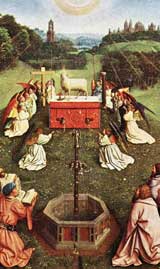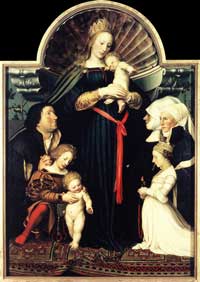Northern Renaissance Artists
Flanders produced artists possessing such an extraordinary technique and deep knowledge of processes that they inspired envy even in Italy, apart from the discovery of oils generally ascribed to them. Jan Van Eyck (c. 1380-1440), aided by his elder brother, Hubert, gave to the world a new revelation with his powerful vision of "The Adoration of the Lamb", of the Ghent Altarpiece. (1425-1429).
Van Eyck brothers were innovators in the use of oils instead of tempera, in drawing, in the study of nature, and perspective. Their works attained technical perfection, and their genius is revealed by the representation of light and shade, as well as of linear and aerial perspective. They were followed by other painters of the Northern Renaissance like Roger Van der Weyden, Hans Memling (1430-1495), Hugo Van der Goes. And later, by Dierck Bouts and Gerard David (1484-1523), by Lucas van der Leyden, Van Orley, and Quentin Matsys (1460-1531).

Jan Van Eyck
Adoration of the Lamb - Detail
The Ghent Altarpiece
Artists in Germany
From about 1425, the German schools of art fluorished. Among them, the School of Cologne became famous due to its Masters of the Great and Lesser Passion, of the Life and Family of the Virgin. But the highest ranked schools were those of Nuremberg, Augsburg, and the Swabian School.
A son of Nuremberg, Albrecht Dürer will become the greatest among the artists of the Northern Renaissance. He was already showing his talent in childhood, when he was apprenticed to the painter Michael Wolgemut, who, together with Martin Schongauer, was at the time a leading master of painting. From that time onwards, Dürer's life as an artist is a record of marvelous progress. He travelled to Venice in 1494 and 1505, and to the Netherlands in 1520. Wherever he went, he enjoyed a triumphant success. Raphael wrote him pages of praise; Bellini became his friend; in Brussels he learned to know Matsys and Van der Leyden, he visited Erasmus.
As an engraver of wood and copper he was incomparable. He was a true humanist, a master of natural sciences and mathematics. His schemes of fortifications as described in his treatises were used in Germany for centuries. He also wrote treatises on measurement, proportions and artistic theory. His works are revealing a deep-hearted thought, grave, almost sad, yet full of love and pity.
First among Augsburg Masters was Albrecht Altdorfer, painter of the magic forests, of Knights and Fauns, of Death, of "The Lovers," and of the "Battle of Arbela." Like Dürer, Altdorfer was a Reformer, and almost the only detail we know concerning him is that he refused to pay for Masses for his soul, but left instead a precious goblet, his wedding-gift to his wife, to be sold for the poor.

Hans Holbein the Younger
Darmstadt Madonna
Schlossmuseum, Darmstadt
Another great master of the Northern Renaissance is Lucas Cranach the Elder (1472-1553). The painter was a Lutheran, yet the least sober, the most fleshly of the German artists, with his coquettish Eves, and his ornate, typical Renaissance, "Fountain of Youth," where older ladies are transformed in young beauties.
The greatest artist of the Swabian School was Hans Holbein the Younger, son of Hans Holbein the Older, who was a famous painter in Augsburg. Holbein is famous for portraits, allegorical and historical subjects. However, he also executed paintings with religious subjects since his early years in Basel, where he created two series of scenes from the Passion.
In 1526, after he finished the Meyer or Darmstadt Madonna, his last great religious work, Holbein decided to go to England, influenced by Erasmus's descriptions of the life at the English court, under the reign of a king who was also a generous patron of arts.
Famous among the works of the Northern Renaissance painters are his portraits of Sir Thomas More, of Warham, Archbishop of Canterbury, and of King Henry VIII. He also made the penetrating portrait drawings of King Henry's courtiers, in the Windsor Castle Royal Collection.